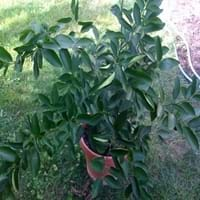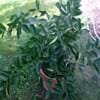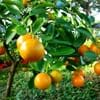Life Span
Perennial
Perennial
Origin
Southern Asia, India, Melanesia, Australia
North America, United States, Northeastern United States, Mid-Atlantic United States, Southeastern United States, North-Central United States, South-Central United States, Texas
Types
Shiraz Limoo,Tahiti lime , Bearss lime
not available
Habitat
Warm soil, Warmer regions
Boggy areas, Fens, Fields, meadows, Swamps, Woodlands
USDA Hardiness Zone
9-11
4-9
Sunset Zone
H1, H2, 8, 9, 12, 13, 14, 15, 16, 17, 18, 19, 20, 21, 22, 23, 24
1a, 1b, 2a, 2b, 3a, 3b, 4, 5, 6, 7
Habit
Oval or Rounded
Thicket/Colonizing
Flower Color
White, Purple
Not Available
Flower Color Modifier
Bicolor
Not Available
Fruit Color
Yellow, Green
Red
Leaf Color in Spring
Green, Dark Green
Not Available
Leaf Color in Summer
Green, Dark Green
Not Available
Leaf Color in Fall
Green, Dark Green
Not Available
Leaf Color in Winter
Light Green
Not Available
Leaf Shape
Lance shaped
Oblovate
Plant Season
Spring, Summer, Fall, Winter
Spring, Fall, Winter
Sunlight
Full Sun, Partial Sun
Full Sun, Partial Sun
Growth Rate
Medium
Medium
Type of Soil
Clay, Loam, Sand
Clay, Loam
The pH of Soil
Acidic, Neutral, Alkaline
Acidic, Neutral, Alkaline
Soil Drainage
Well drained
Average
Bloom Time
Indeterminate
Late Spring
Tolerances
Drought
Not Available
Where to Plant?
Ground, Pot
Ground, Pot
How to Plant?
Grafting, Layering
Divison, Seedlings
Plant Maintenance
Medium
Medium
Watering Requirements
Do Not over Water
Keep the ground moist but not water-logged
In Summer
Lots of watering
Lots of watering
In Spring
Moderate
Moderate
In Winter
Average Water
Average Water
Soil pH
Acidic, Neutral, Alkaline
Acidic, Neutral, Alkaline
Soil Type
Clay, Loam, Sand
Clay, Loam
Soil Drainage Capacity
Well drained
Average
Sun Exposure
Full Sun, Partial Sun
Full Sun, Partial Sun
Pruning
Remove damaged leaves, Remove dead branches, Remove dead leaves
Prune after flowering, Prune in early spring, Remove damaged leaves, Remove dead branches, Remove dead leaves
Fertilizers
All-Purpose Liquid Fertilizer
All-Purpose Liquid Fertilizer, Compost, Fertilize every year, Mulch, Nitrogen
Pests and Diseases
Mites
Aphids, Apple Maggot, Fall Webworm, Red blotch, Scale
Plant Tolerance
Drought
Not Available
Flower Petal Number
Single
Not Available
Fragrant Bark/Stem
Yes
No
Foliage Texture
Medium
Not Available
Foliage Sheen
Glossy
Not Available
Attracts
Birds, Butterflies
Birds
Allergy
Skin rash
Not Available
Aesthetic Uses
Not Available
Showy Purposes
Beauty Benefits
Not Available
Not Available
Environmental Uses
Air purification
Air purification
Medicinal Uses
Antibacterial, Astringent, Carminative, Refrigerant
Not Available
Part of Plant Used
Fruits
Fruits
Other Uses
Cleanser, Repellent
Used As Food, Used as Ornamental plant
Used As Indoor Plant
No
No
Used As Outdoor Plant
Yes
Yes
Garden Design
Container, Edible, Feature Plant, Fruit / Fruit Tree, Houseplant, Shade Trees, Topiary / Bonsai / Espalier, Tropical
Cutflower, Mixed Border, Screening, Wind Break
Botanical Name
CITRUS latifolia
ARONIA arbutifolia
Common Name
Persian Lime
Red Chokeberry
In Hindi
Persian lime
लाल Chokeberry
In German
Gewöhnliche Limette
Rote Apfelbeere
In French
Citrus × latifolia
Red Chokeberry
In Spanish
Citrus latifolia
rojo Chokeberry
In Greek
Persian lime
κόκκινο Chokeberry
In Portuguese
Citrus × latifolia
Red Chokeberry
In Polish
Persian lime
Red aronii
In Latin
Persian lime
arbutifolia
Phylum
Vascular plant
Magnoliophyta
Class
Magnoliopsida
Magnoliopsida
Clade
Angiosperms, Eudicots, Rosids
Angiosperms, Eudicots, Rosids
Tribe
Not Available
Not Available
Subfamily
Not Available
Not Available
Number of Species
Not Available
Not Available
Importance of Persian Lime and Red Chokeberry
Want to have the most appropriate plant for your garden? You might want to know the importance of Persian Lime and Red Chokeberry. Basically, these two plants vary in many aspects. Compare Persian Lime and Red Chokeberry as they differ in many characteristics such as their life, care, benefits, facts, etc. Every gardener must at least have the slightest clue about the plants he wants to plant in his garden. Compare their benefits, which differ in many ways like facts and uses. The medicinal use of Persian Lime is Antibacterial, Astringent, Carminative and Refrigerant whereas of Red Chokeberry is Not Available. Persian Lime has beauty benefits as follows: Not Available while Red Chokeberry has beauty benefits as follows: Not Available.
Compare Facts of Persian Lime vs Red Chokeberry
How to choose the best garden plant for your garden depending upon its facts? Here garden plant comparison will help you to solve this query. Compare the facts of Persian Lime vs Red Chokeberry and know which one to choose. As garden plants have benefits and other uses, allergy is also a major drawback of plants for some people. Allergic reactions of Persian Lime are Skin rash whereas of Red Chokeberry have Not Available respectively. Having a fruit bearing plant in your garden can be a plus point of your garden. Persian Lime has showy fruits and Red Chokeberry has showy fruits. Also Persian Lime is not flowering and Red Chokeberry is not flowering . You can compare Persian Lime and Red Chokeberry facts and facts of other plants too.





